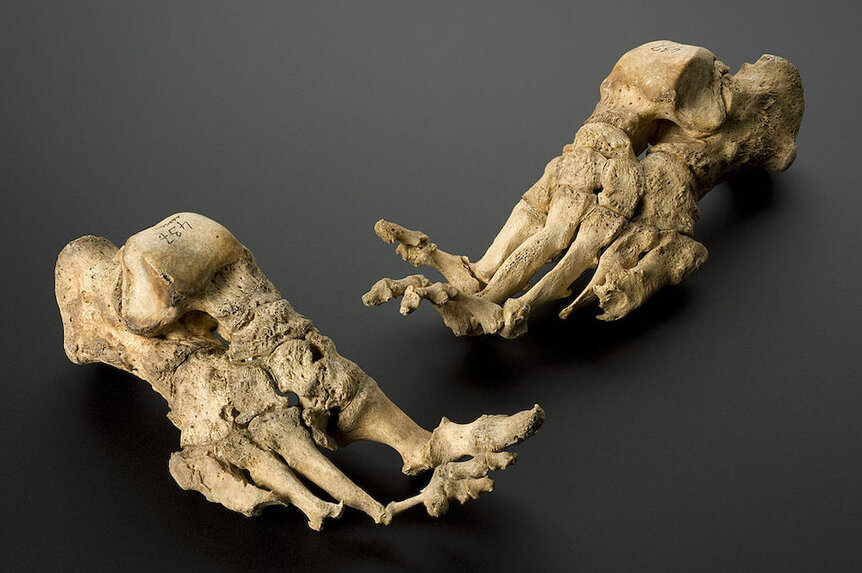Create a free profile to get unlimited access to exclusive videos, sweepstakes, and more!
What happened to Viserys' face? 'House of the Dragon' and the science of leprosy
There are worse things than dragons in Westeros... and in real life.

The A Song of Ice and Fire universe is no stranger to death and disease. In Game of Thrones, viewers were introduced to a fictional disease called greyscale which caused the skin to harden and calcify. The first spin-off show, the prequel House of the Dragon, has its own disease, and this ailment is a little more realistic but just as fatal. Warning: Spoilers ahead for House of the Dragon.
From the start, King Viserys has been unwell, and he's looked worse and worse with each time jump as his condition progressed. What began as open wounds turned into amputations — and worse. By the eighth episode, “The Lord of Tides,” King Viserys is well into the throes of an unnamed yet familiar disease. The open sores, delirium brought on in part by milk of the poppy, and a horrifying wasting of his face aren't the worst of it. At one point, the king removes his golden mask to reveal a face missing the right eye and part of the cheek. Sinew and teeth peek out through a rotting hole. What happened to Viserys, and is such a condition possible in the real world?
WHAT DOES VISERYS HAVE?
In a recent podcast interview with Entertainment Weekly, Paddy Considine — the actor portraying Viserys — revealed that his character has a kind of leprosy.
“He’s actually suffering from a form of leprosy. His body is deteriorating, his bones are deteriorating. He’s not actually old. He’s still a young man in there, he’s just unfortunately got this thing that’s kind of taken over his body. It becomes a metaphor for being king and the stress and strain it puts on you. What it does to you physically. What it does to you mentally,” Considine said.
What we know about leprosy lines up nicely with the symptoms we see on screen. Infection can lead to nerve damage, respiratory problems, and damage to the skin and eyes. Viserys has ticked every box on the leprosy checklist and then some.
While leprosy is a creation of our own world and not a fantasy of George R.R. Martin or an HBO writer’s room, its history would fit nicely in the mythos of Westeros. Our oldest evidence of the disease hails from 4,000 years ago in India. There, archaeologists have uncovered an ancient skeleton with erosion patterns similar to those found in modern leprosy patients. The disease later traveled across the globe, resulting in 19,000 leprosy hospitals across Europe by the year 1200.
At the time, and leading up to the 20th century, leprosy was thought to be a highly contagious and ultimately debilitating disease. As a result, people who had contracted leprosy were often segregated from the rest of the population in what became known as leper colonies, not unlike the Stone Men in Old Valyria. (Greyscale, the fictional disease in the series, clearly is inspired by leprosy even if the symptoms are more fantastical.) Such seggregation was the most effective and only real long-term strategy for dealing with the disease until the advent of effective medical treatments.
Today, however, folks who contract leprosy are likely to suffer more from stigma than the actual disease. It turns out leprosy isn’t actually that contagious and is likely transmitted through frequent contact with untreated cases, probably through the release of oral and nasal droplets. Treatment with antibiotics is highly effective and once treatments starts, patients are no longer contagious and can go about their ordinary lives. If caught relatively early, there are no longstanding consequences to infection.
WHERE DOES IT COME FROM AND WHAT DOES IT DO?
It’s not quite clear precisely how leprosy spreads from person to person but scientists suspect it happens when a contagious person coughs or sneezes, releasing infected droplets into the air. That’s important because it means you can’t catch it through casual contact. Shaking hands and hugging or hanging out in the same space isn’t a risk as long as you’re not coughing all over one another.
We may not know for certain how the pathogen spreads, but we do know what the pathogen is. Leprosy is caused by the bacteria Mycobacterium leprae which, in actuality, isn’t all that threatening. Roughly 95 percent of the population has a natural immunity. Even if you were to be infected, you’d probably never know it. Your immune system would fight it off before it ever had a chance to take hold.
That’s partly because there is a lot of lead time before the disease starts causing problems. According to the CDC, Mycobacterium leprae is a slow-growing bacterium that can take up to 20 years before it mounts enough of a force to cause symptoms. All of this could explain why, in House of the Dragon, nobody around Viserys, including his wife, has seemingly caught whatever he has.
If you think you might have been exposed, either from a contagious person or an armadillo — they naturally carry the M. leprae bacterium which causes leprosy — it’s probably nothing to worry about. There’s only one chance in twenty that you’ll ever have any symptoms. Still, it’s ill-advised to roll the dice. Your healthcare provider can and should do regular skin inspections and monitor for symptoms. If and when they do appear, a cocktail of antibiotics will clear it right up.
If, however, you find yourself isolated from modern medical intervention and infected with the bacterium, you might have a bad time of it, should you wait long enough. First, you’ll experience discolored skin which might lose feeling, growths, ulcers, swollen earlobes, and your eyebrows or eyelashes might fall out. As the disease progresses and starts affecting your nerves, you might experience numbness, muscle weakness or paralysis. You might have more frequent nosebleeds.
Eventually, nerve damage worsens until you lose feeling in your extremities and in your eyes. Paralysis of the hands and feet is followed by reabsorption of the fingers and toes by the body. Loss of feeling in the eyes leads to damage and ultimately blindness.
While many of Viserys's symptoms sound a lot like leprosy, his injuries are played for drama, not realism. Contrary to popular belief, leprosy is not a flesh-eating disease. It does cause lesions in the skin, but they aren't so severe that they'd eat all the way through your face. Injury among people with leprosy is most often caused by a lack of sensation. Progressive nerve damage blocks feeling in the extremities, including the hands, feet, and nose, as well as the eyes, leaving individuals more prone to injury. If you can't feel your fingers and toes, you're more likely to break them, probably more than once. If you can't feel a grain of sand in your eye, it's more likely to grind away unabated. Physical injuries are a very real part of the disease, but they are largely secondary consequences, not directly caused by the infection.
It's difficult to imagine how leprosy might have led to the unique set of injuries Viserys had. More likely, he'd have retained both eyes with diminished or lost vision and he'd still have his cheek but lose (more) fingers and toes. Maybe his nose. The years leading up to Viserys’s death would have been painful and horrifying as a bacterial infection slowly paralyzed and consumed his body. But it probably wouldn't have played out quite the way we see it on screen. Milk of the poppy might have dulled some of the pain, but when it comes to leprosy King Antibiotics sits firmly on the iron throne.
Looking for more fantasy adventure? The entire Harry Potter film saga is streaming now on Peacock.




























